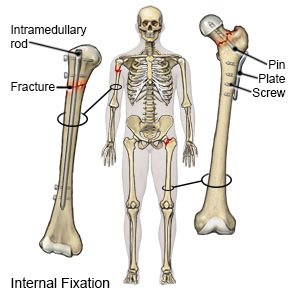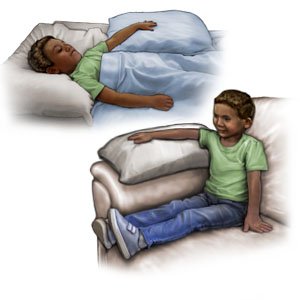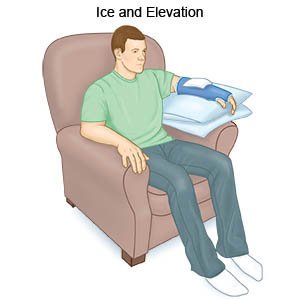ORIF of an Arm Fracture in Children
Medically reviewed by Drugs.com. Last updated on Aug 4, 2025.
Open reduction and internal fixation (ORIF) of an arm fracture is surgery to fix a broken arm bone. Open reduction means the bones are moved back into the correct position. Internal fixation means plates, screws, pins, or wires will be used to hold the bones in place while they heal.
 |
DISCHARGE INSTRUCTIONS:
Call your local emergency number (911 in the US) if:
- Your child has chest pain, a fast heartbeat, trouble breathing, or has fainted.
Seek care immediately if:
- Blood soaks through your child's bandage.
- Your child's cast or splint breaks or gets damaged.
- Your child's stitches or staples come apart.
- Your child has more swelling in his or her fingers.
- Your child's fingers look pale or blue, feel numb, or tingle.
Call your child's doctor or surgeon if:
- Your child tells you that the cast feels too tight.
- Your child has a fever.
- Your child's cast gets wet.
- Your child's cast or splint breaks or begins to smell.
- Your child's wound is red, swollen, or draining pus.
- Your child's pain does not get better, even after he or she takes pain medicine.
- You have questions or concerns about your child's condition or care.
Medicines:
Your child may need any of the following:
- Prescription pain medicine may be given. Ask your child's healthcare provider how to give this medicine safely. Some prescription pain medicines contain acetaminophen. Do not give other medicines that contain acetaminophen without talking to a healthcare provider. Too much acetaminophen may cause liver damage. Prescription pain medicine may cause constipation. Ask your child's healthcare provider how to prevent or treat constipation.
- Antibiotics help fight or prevent an infection caused by bacteria.
- Do not give aspirin to children younger than 18 years. Your child could develop Reye syndrome if he or she has the flu or a fever and takes aspirin. Reye syndrome can cause life-threatening brain and liver damage. Check your child's medicine labels for aspirin or salicylates.
- Give your child's medicine as directed. Contact your child's healthcare provider if you think the medicine is not working as expected. Tell the provider if your child is allergic to any medicine. Keep a current list of the medicines, vitamins, and herbs your child takes. Include the amounts, and when, how, and why they are taken. Bring the list or the medicines in their containers to follow-up visits. Carry your child's medicine list with you in case of an emergency.
Care for your child:
- Limit activity. Your child will not be able to lift or move heavy objects after surgery. Ask your child's healthcare provider about the best activities for your child.
- Elevate the arm. This will help relieve pain and swelling. Keep the arm above the level of your child's heart as often as possible. Prop the arm on pillows or blankets to keep it elevated comfortably.

- Apply ice to the surgery area. Ice helps decrease swelling and pain. Ice may also help prevent tissue damage. Use an ice pack, or put crushed ice in a plastic bag. Cover it with a towel and place it on your child's arm, cast, or splint for 15 to 20 minutes every hour or as directed.

- Ask when your child can bathe. When your child is allowed to bathe, cover the cast with 2 plastic bags. Tape the bags to his or her skin to keep the water out. Keep the cast out of the water so it does not get wet. If your child does not have a cast, carefully wash the surgery wound with soap and water. Dry the area and put on new, clean bandages as directed. Change the bandages when they get wet or dirty.
Cast or splint care:
- Check the skin around your child's cast or splint every day. Apply lotion on any red or sore areas.
- Do not let your child push down or lean on any part of the cast or splint, because it may break.
- Do not let your child scratch the skin under the cast with any sharp or pointed object.
- If your child's splint is too tight, gently loosen it so that his or her fingers are comfortable.
- Have your child wiggle his or her fingers each day. This will help relieve swelling.
Take your child to physical therapy, if directed:
A physical therapist can teach your child exercises to help improve movement and decrease pain. Physical therapy can also help improve strength and decrease your child's risk for loss of function.
Follow up with your child's doctor or surgeon as directed:
Your child will need to return to have the surgery wound checked and stitches or staples removed. Write down your questions so you remember to ask them during your visits.
© Copyright Merative 2025 Information is for End User's use only and may not be sold, redistributed or otherwise used for commercial purposes.
The above information is an educational aid only. It is not intended as medical advice for individual conditions or treatments. Talk to your doctor, nurse or pharmacist before following any medical regimen to see if it is safe and effective for you.
Further information
Always consult your healthcare provider to ensure the information displayed on this page applies to your personal circumstances.
